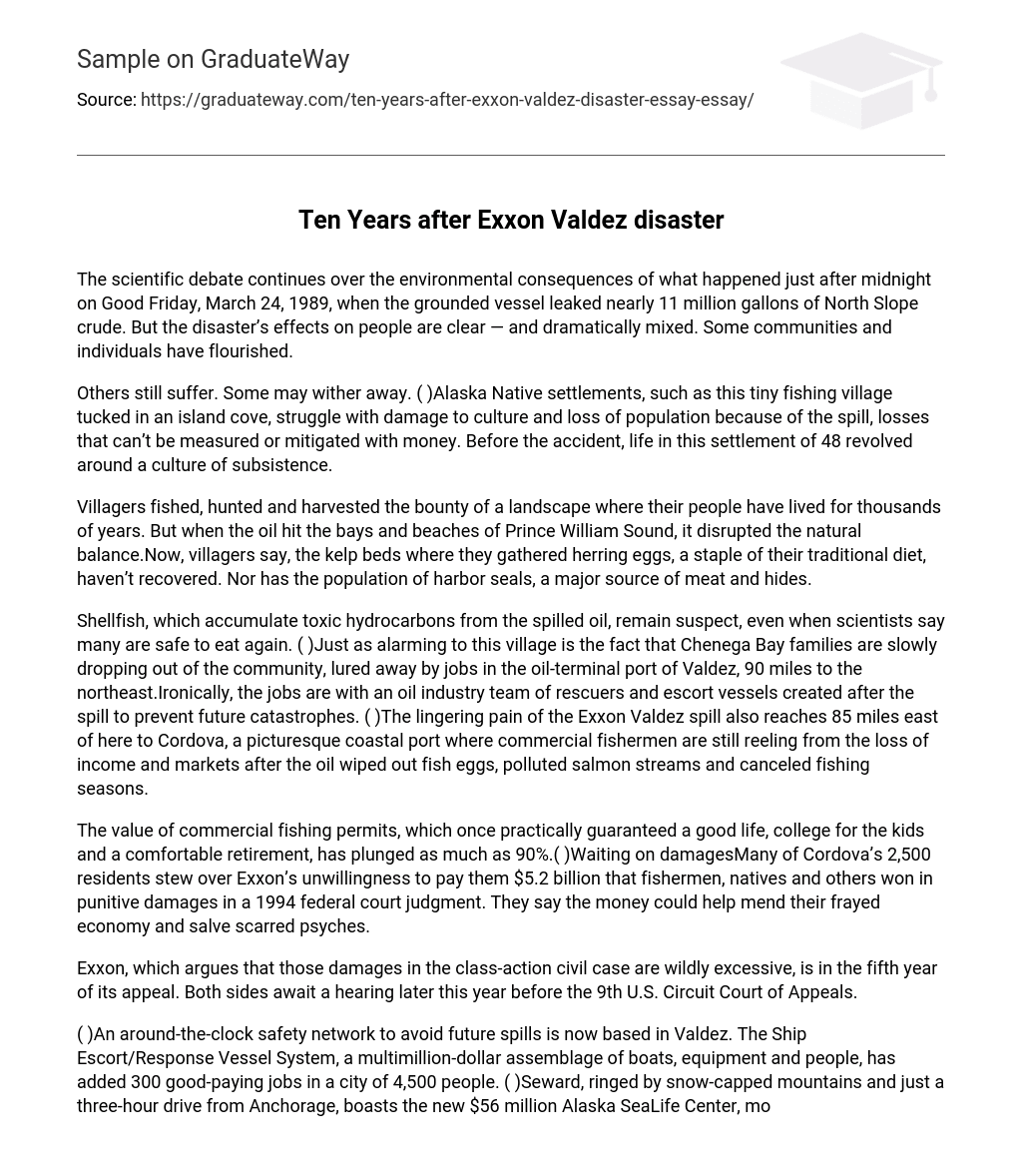The scientific debate continues over the environmental consequences of what happened just after midnight on Good Friday, March 24, 1989, when the grounded vessel leaked nearly 11 million gallons of North Slope crude. But the disaster’s effects on people are clear — and dramatically mixed. Some communities and individuals have flourished.
Others still suffer. Some may wither away. ( )Alaska Native settlements, such as this tiny fishing village tucked in an island cove, struggle with damage to culture and loss of population because of the spill, losses that can’t be measured or mitigated with money. Before the accident, life in this settlement of 48 revolved around a culture of subsistence.
Villagers fished, hunted and harvested the bounty of a landscape where their people have lived for thousands of years. But when the oil hit the bays and beaches of Prince William Sound, it disrupted the natural balance.Now, villagers say, the kelp beds where they gathered herring eggs, a staple of their traditional diet, haven’t recovered. Nor has the population of harbor seals, a major source of meat and hides.
Shellfish, which accumulate toxic hydrocarbons from the spilled oil, remain suspect, even when scientists say many are safe to eat again. ( )Just as alarming to this village is the fact that Chenega Bay families are slowly dropping out of the community, lured away by jobs in the oil-terminal port of Valdez, 90 miles to the northeast.Ironically, the jobs are with an oil industry team of rescuers and escort vessels created after the spill to prevent future catastrophes. ( )The lingering pain of the Exxon Valdez spill also reaches 85 miles east of here to Cordova, a picturesque coastal port where commercial fishermen are still reeling from the loss of income and markets after the oil wiped out fish eggs, polluted salmon streams and canceled fishing seasons.
The value of commercial fishing permits, which once practically guaranteed a good life, college for the kids and a comfortable retirement, has plunged as much as 90%.( )Waiting on damagesMany of Cordova’s 2,500 residents stew over Exxon’s unwillingness to pay them $5.2 billion that fishermen, natives and others won in punitive damages in a 1994 federal court judgment. They say the money could help mend their frayed economy and salve scarred psyches.
Exxon, which argues that those damages in the class-action civil case are wildly excessive, is in the fifth year of its appeal. Both sides await a hearing later this year before the 9th U.S. Circuit Court of Appeals.
( )An around-the-clock safety network to avoid future spills is now based in Valdez. The Ship Escort/Response Vessel System, a multimillion-dollar assemblage of boats, equipment and people, has added 300 good-paying jobs in a city of 4,500 people. ( )Seward, ringed by snow-capped mountains and just a three-hour drive from Anchorage, boasts the new $56 million Alaska SeaLife Center, more than half of it paid for with money from Exxon’s $1 billion settlement of federal and state claims over damage from the spill. On a point overlooking Resurrection Bay, the center is a showcase for the study of marine mammals, birds and fish, a rehabilitation center for injured wildlife, and a busy tourist attraction.
( )Such infusions of money and new jobs aren’t always popular with Alaska Natives, who see some of the changes as costly to their cherished culture. Efforts to buy more coastal properties as permanent havens for wildlife threatened by the spill have upset some villagers because the lands being sold are theirs. Using some of the Exxon settlement money, the state and federal governments’ Exxon Valdez Oil Spill Trustee Council has bought more than 635,000 acres of Alaska Native lands. The purchases enrich the tribal corporations that sell the properties.
But the purchases have split some native communities because those holdings were originally acquired after long, hard battles for native rights.“Ownership of land is power. This is the death knell of what we worked for,” says Eyak corporation member Sylvia Lange, 46, of Cordova, whose people are selling 75,000 of their 148,000 acres.Ten years later, the accident has left more than memories of 1,500 miles of blackened beaches, hundreds of thousands of dead birds and a slick that spread 500 miles beyond the sound.
( )Environmental sociologist J. Steven Picou of the University of South Alabama, who has studied Prince William Sound’s residents extensively, says that in 1997, 40% of commercial fishermen in Cordova still had symptoms of severe depression and post-traumatic stress disorder. ( )Atop all that, the polluting of a world-class salmon fishery rearranged markets and demand for the sound’s catch. “People didn’t want to buy salmon out of an oiled fishery,” says Minneapolis lawyer Brian O’Neill, lead lawyer in the class-action case against Exxon.
“These guys just lost shelf space permanently.” Despite gradual recovery of local fishery stocks, salmon from the sound is still tainted by the bad publicity, if not by the oil. ( )Phil Lian, 59, a third-generation Alaskan, lost his fishing net supply business, then his marriage, in Cordova’s economic and social upheaval. Lian, who also was a fisherman, is one of more than 30,000 residents of the sound who might claim a share of the $5.
2 billion court judgment against Exxon. Unless the oil company pays up, “I’m retiring on welfare,” he says. Although efforts are under way to diversify the town’s economy, “we’re all walking wounded,” says bookstore owner Kelley Weaverling, 52, who was Cordova’s mayor in 1991-93. “The social fabric of this community was just pulled and stretched and torn.”





